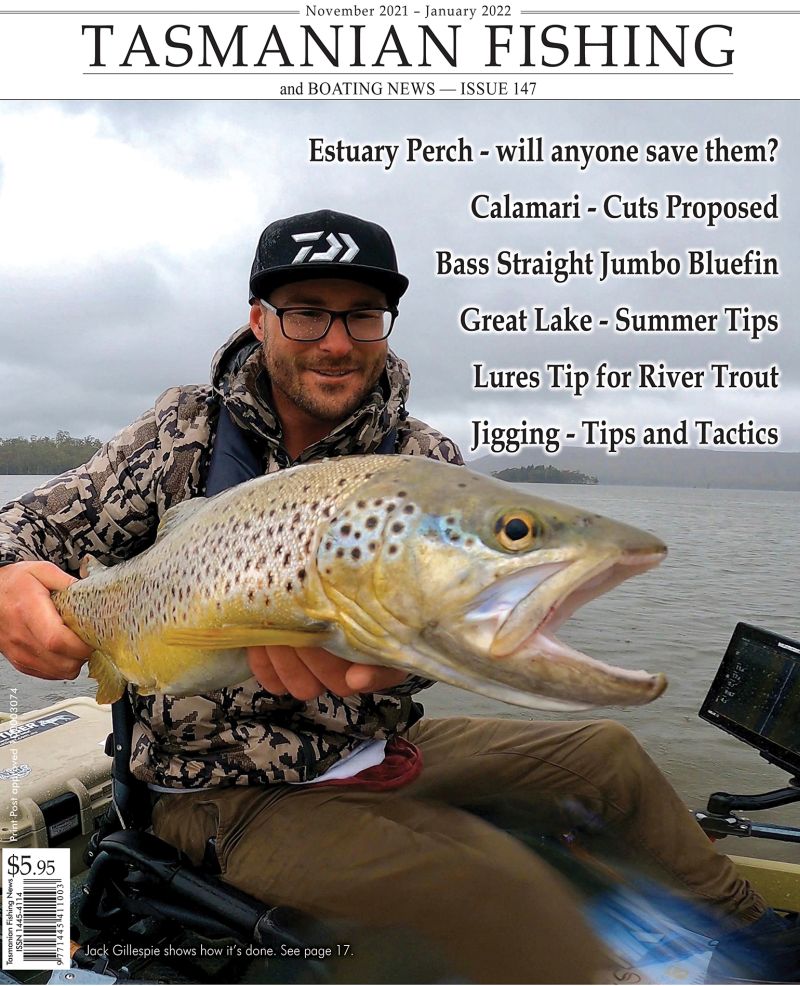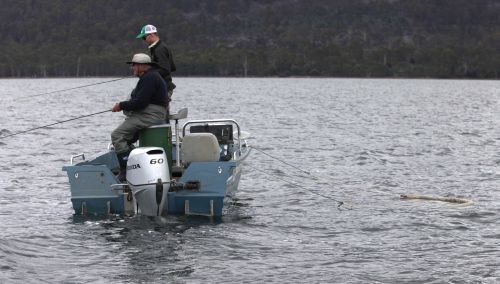From the Archives ...
Atlantic Salmon At Large
Atlantic Salmon At Large
Recently Atlantic salmon seems to be a very hot topic amongst local anglers, especially those in the south of the state in the D'Entrecasteaux area. Northern anglers should take a close look at the Tamar as there are opportunities here as well.
The recent "great escape" has provided a perfect opportunity for fresh and saltwater anglers alike to experience some truly memorable sport. Tasmania's pristine, clean and cool waters are the perfect nursery for the Atlantic Salmon and as our local fish farms produce more and more fresh quality seafood it is a fact that there are going to be tangible consequences.
Bluefin mania continues
Brown Dog!
Here we are into June and the game-fishing season is well and truly in full swing in the south, but not just the south. Over the past month we have seen many albacore in the 15 - 20 kilo range caught off St.Helens - not to mention the huge Australian record bluefin that weighed in at an incredible 153 kilo's. But it is in the south of the state that anglers are really having a ball!
Eaglehawk Neck is on fire as those anglers that fished the recent Southern Bluefin Championships found out. I am not aware of a single boat that didn't land multiple bluefin for the competition and organisers even ran out of "catch & release" tags on the first day, certainly the best competition to have been held out of "The Neck" for many years.
- Category: Tuna Fishing and other Game Fishing
- Hits: 7022
Land Based Game Fishing
Simon KernanThinking back to the day before, and the 3½ hour hike through the bush, I wondered if today was going to be any different from the many trips before to this location.
- Category: Tuna Fishing and other Game Fishing
- Hits: 22760
The bluefin cometh
Cool currentsAs the weather cools and sea temperatures slow start to decline, preparations (and hopes) turn toward the possibility of another good blue fin tuna run. Digressing momentarily, I received a phone call from Leroy at Big Fin Sports fishing. The result of conversation was the Land Based Game article, I previously mentioned was placed in the hands of "Simon" who without doubt has LBG miles on the board both here and interstate. Simon has had some fantastic captures including a few good Kingfish captures from places here in Tasmania and is indelibly qualified on the subject matter.
So again at short notice I was again asked to stab my little sausages on the keyboard and come up with an article for aspiring anglers chasing blue fin tuna. The article is a follow up with technical information and is again aimed squarely between the eyes of the more beginner, novice or inexperienced blue water wanderers.
- Category: Tuna Fishing and other Game Fishing
- Hits: 7537
Chasing chooks
Tim Anderson takes a look at one of the mainstays of Tasmania's gamefishing. Albacore are not as regal as marlin, yellowfin or bluefin, but they are fun to catch and great to eat.
The build up
What smells like fish and tastes like chicken? This question has so often been asked by the likes of Cheech and Chong and although the very term conjures up images of "hedgehogs" and alley cats, rarely has the question been posed in this arena.
The answer I am looking for in this forum is obviously albacore tuna.
- Category: Tuna Fishing and other Game Fishing
- Hits: 7592
Pedra Branca Bluefin Bonanza
Tim Anderson
Tim Anderson tells the tale of an extraordinary fishing event-fishing for Southern bluefin tuna off Tasmania's south east coast.
- Category: Tuna Fishing and other Game Fishing
- Hits: 9877
GAME & SPORT FISHING WITH SOFT PLASTICS
By Starlo & Bushy** This feature article is based on extracts from Starlo & Bushy's great how-to book "On Soft Plsastics", published in 2005 by AFN Publishing of Melbourne.
At first glance, fast-swimming pelagic species such as tailor, salmon, trevally, tuna and mackerel might seem to be the least likely candidates for successful soft plastic fishing. In actual fact, nothing could be further from the truth.
- Category: Tuna Fishing and other Game Fishing
- Hits: 9753
NORTH COAST MAKO's
Harry Murfet
An exciting new sport fishery has emerged and it adds another dimension to the usual bread and butter fishing that is associated with Tasmania's North Coast.
Mako sharks have always been present in Bass Strait waters but it is only in recent years that a few innovative anglers, sick of catching couta, pike, salmon and flathead, decided to target these gamefish. In doing so, becoming pioneers of Bass Strait game fishing.
Makos are a pelagic species, roaming the ocean in search of food that consists of squid and, in the case of Bass Strait, school fish like mackerel, salmon, mullet and couta. While most North Coast makos are juveniles in the 30 - 50 kg. range, there are plenty of reports of fish hooked, lost and landed over the 100 kg mark this year.
- Category: Tuna Fishing and other Game Fishing
- Hits: 8316
It's Bluefin Time Again!
Once again it's that time of year when avid game fishermen pull out their gear and give it the once over in anticipation of the arrival of the mighty southern bluefin tuna. These powerhouse fish put both angler skill and product quality to the ultimate test each year and anglers look forward to the challenge.
- Category: Tuna Fishing and other Game Fishing
- Hits: 5382
Low Head Makos
Mako sharks are not a species I would normally chase, and especially not at the mouth of the Tamar River. That is until Andrew Hart off Hook Line and Sinker caught the first mako shark taken on rod and reel off Low Head last season.
- Category: Tuna Fishing and other Game Fishing
- Hits: 9183
Plan a Game Fishing Charter Now
There is some amazing game fishing, right on Tasmania's doorstep. The amount of albacore, yellowfin tuna, bluefin tuna, striped tuna and striped marlin is the envy of most areas of the mainland.
- Category: Tuna Fishing and other Game Fishing
- Hits: 5931
Current TFBN
Click above for current issue content. The current issue of TFBN is extensive and topical. In Tackle Stores, Newsagents and by subscription.
Delivered to your door for $48 for 2 years (8 issues). To subscribe, send Mike $48 via www.paypal.com.au . (Basic instructions are here) The email is at Contact Us. Your address will be included from PayPal.
Or phone Mike with your c/c handy on 0418129949
Please ensure your details are correct, for Mike to organise delivery.
TFBN Newsletter Sign up Form
Why not submit an article ?
When you have finished for the day, why not have a brag about the ones that didn't get away! Send Mike an article on your fishing (Click here for contact details), and we'll get it published here. Have fun fishing - tasfish.com
Category Descriptions
Here is a list of all of the Article Categories. The number in Brackets, eg (13) is the number of articles. Click on Derwent River and all articles relating to the Derwent will be displayed in the central area.
Articles by Category
-
Rivers (3)
-
Saltwater and Estuary Fishing (149)
-
Kayak Fishing (34)
-
Lakes (1)
-
Great Lake (62)
-
Lake Leake (52)
-
Woods Lake (16)
-
Lake Augusta (11)
-
Huntsman Lake (13)
-
Lake Pedder and Gordon (10)
-
Lake Dulverton (5)
-
Lake Crescent (6)
-
Tooms Lake (10)
-
Lake Mackintosh (2)
-
Lake Barrington (5)
-
Little Lake (8)
-
Meadowbank Lake (5)
-
Lake King William (7)
-
Lake St Clair (2)
-
Western Lakes (12)
-
Arthurs Lake (35)
-
Lake Echo (7)
-
Four Springs (54)
-
Lake Sorell (7)
-
Lake Burbury (6)
-
Other Lakes (57)
-
Brushy Lagoon (18)
-
Little Pine Lagoon (5)
-
Penstock Lagoon (16)
-
Brumbys Creek (7)
-
-
Events (48)
-
Estuary Fishing (0)
-
Coastal Catches (46)
-
Super Trawler (46)
-
IFS, DPIPWE, MAST and Peak Bodies (435)
-
Commercial Interests (98)
-
Other (24)
-
TFBN Back Issues (8)
-
Fly Fishing (67)
-
Trout Fishing (252)
-
Meteorology and Weather (8)
-
Jan’s Flies (50)
-
Tuna Fishing and other Game Fishing (86)
-
Cooking Fish (19)
-
Fishing Information (1)
-
Fishing Books (8)
-
Videos (5)
-
Tackle, Boats and other Equipment (146)
-
World Fly Fishing Championship 2019 (2)
Popular Tags
windyty.com
Visit https://www.windyty.com/
Rubicon Web and Technology Training
Hello everyone, I thought it would be a good time to introduce myself.
My name is Stephen Smith and I have been managing the website tasfish.com since May 2009.
It has been an epic journey of learning and discovery and I am indebted to Mike Stevens for his help, support and patience.
I am developing a new venture Rubicon Web and Technology Training ( www.rwtt.com.au ). The focus is two part, to develop websites for individuals and small business and to train people to effectively use technology in their everyday lives.
Please contact me via www.rwtt.com.au/contact-me/ for further information - Stephen Smith.
From the Archives ... (last chance)
Suggestions for Early Season Waters
Suggestions for Early Season Waters
by Sarah Graham
Many anglers are preparing for the opening of the new angling season on Saturday 7 August and it's shaping up to be another good one with the fishery in excellent health as a result of last year’s drought breaking rains. There are many great fishing locations around the State from which to choose for the opening weekend and early season fishing but here are a few suggestions.



